Portfolio Strategy Insights Using Historical Data (2007-2016)
VerifiedAdded on 2020/06/06
|13
|3276
|60
AI Summary
The assignment involves a detailed analysis of the performance of US stocks and real estate investments over a period from 2007 to 2016. It examines metrics such as average annual returns, standard deviations, and portfolio beta values for both asset classes. The study highlights significant findings like an average return of 1.18% for stocks and 1.52% for real estate, alongside their respective standard deviations (18.53% and 21.34%). Correlation coefficient calculations indicate a perfect correlation between these two assets during the period. Further insights are provided into portfolio management strategies through decomposition analysis, considering factors like risk-free rate, market premium, investor's risk, manager's risk, selectivity, diversification benefits, and net selectivity. The assignment encapsulates investment performance under varying economic conditions while emphasizing strategic portfolio adjustments to optimize returns.

Portfolio Management
Paraphrase This Document
Need a fresh take? Get an instant paraphrase of this document with our AI Paraphraser
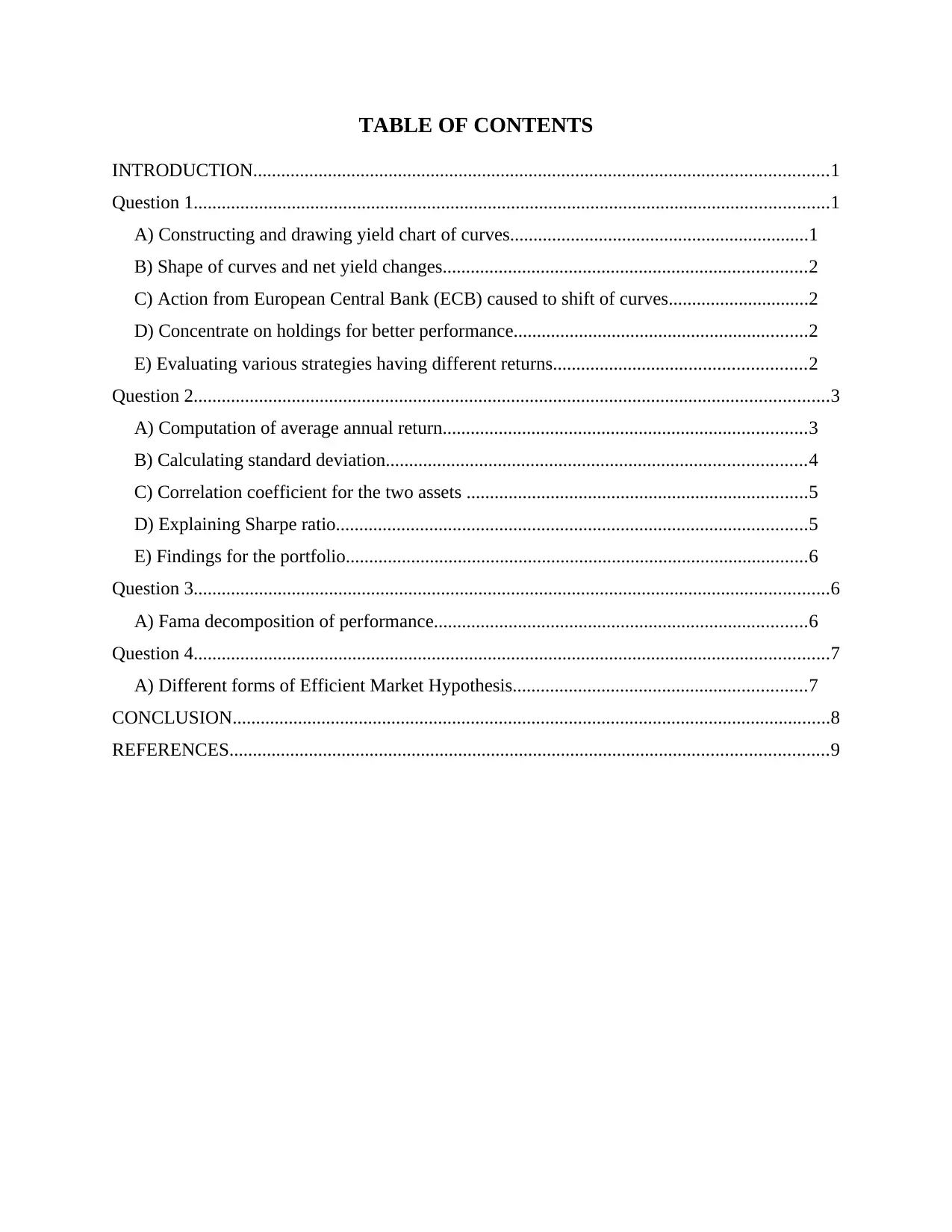
TABLE OF CONTENTS
INTRODUCTION...........................................................................................................................1
Question 1........................................................................................................................................1
A) Constructing and drawing yield chart of curves................................................................1
B) Shape of curves and net yield changes..............................................................................2
C) Action from European Central Bank (ECB) caused to shift of curves..............................2
D) Concentrate on holdings for better performance...............................................................2
E) Evaluating various strategies having different returns......................................................2
Question 2........................................................................................................................................3
A) Computation of average annual return..............................................................................3
B) Calculating standard deviation..........................................................................................4
C) Correlation coefficient for the two assets .........................................................................5
D) Explaining Sharpe ratio.....................................................................................................5
E) Findings for the portfolio...................................................................................................6
Question 3........................................................................................................................................6
A) Fama decomposition of performance................................................................................6
Question 4........................................................................................................................................7
A) Different forms of Efficient Market Hypothesis...............................................................7
CONCLUSION................................................................................................................................8
REFERENCES................................................................................................................................9
INTRODUCTION...........................................................................................................................1
Question 1........................................................................................................................................1
A) Constructing and drawing yield chart of curves................................................................1
B) Shape of curves and net yield changes..............................................................................2
C) Action from European Central Bank (ECB) caused to shift of curves..............................2
D) Concentrate on holdings for better performance...............................................................2
E) Evaluating various strategies having different returns......................................................2
Question 2........................................................................................................................................3
A) Computation of average annual return..............................................................................3
B) Calculating standard deviation..........................................................................................4
C) Correlation coefficient for the two assets .........................................................................5
D) Explaining Sharpe ratio.....................................................................................................5
E) Findings for the portfolio...................................................................................................6
Question 3........................................................................................................................................6
A) Fama decomposition of performance................................................................................6
Question 4........................................................................................................................................7
A) Different forms of Efficient Market Hypothesis...............................................................7
CONCLUSION................................................................................................................................8
REFERENCES................................................................................................................................9

INTRODUCTION
Portfolio management is required in order to assess risk associated with market securities.
Present report deals with importance of portfolio management for investors. Moreover, it also
lists down yield charts of curves of bonds and outline the performance of the same. There are
various actions taken by ECB bank that has caused shift in yield curves. Furthermore, various
strategies consisting of different returns are also discussed in this report. Annual return on
portfolio and standard deviation of the portfolio are calculated. Furthermore, correlation
coefficient is also computed that shows whether there is positive or negative correlation between
two variables. Sharpe ratio is also calculated for assessing adjusted risk free return on the
securities. Moreover, Fama decomposition performance measure is carried out for evaluating
risk associated with returns in the best possible manner and various components are discussed as
well. Furthermore, different forms of EMH for analysing share price at the end of month are
explained which help investors to assess performance of company and take structured decisions.
Question 1
A) Constructing and drawing yield chart of curves
Year 2007 August 2009 August
3 month 3.97% 0.41%
1 year 4.07% 0.78%
2 year 4.10% 1.47%
5 year 4.16% 2.73%
7 year 4.24% 3.24%
10 year 4.33% 3.73%
20 year 4.49% 4.28%
30 year 4.55% 4.31%
1
Portfolio management is required in order to assess risk associated with market securities.
Present report deals with importance of portfolio management for investors. Moreover, it also
lists down yield charts of curves of bonds and outline the performance of the same. There are
various actions taken by ECB bank that has caused shift in yield curves. Furthermore, various
strategies consisting of different returns are also discussed in this report. Annual return on
portfolio and standard deviation of the portfolio are calculated. Furthermore, correlation
coefficient is also computed that shows whether there is positive or negative correlation between
two variables. Sharpe ratio is also calculated for assessing adjusted risk free return on the
securities. Moreover, Fama decomposition performance measure is carried out for evaluating
risk associated with returns in the best possible manner and various components are discussed as
well. Furthermore, different forms of EMH for analysing share price at the end of month are
explained which help investors to assess performance of company and take structured decisions.
Question 1
A) Constructing and drawing yield chart of curves
Year 2007 August 2009 August
3 month 3.97% 0.41%
1 year 4.07% 0.78%
2 year 4.10% 1.47%
5 year 4.16% 2.73%
7 year 4.24% 3.24%
10 year 4.33% 3.73%
20 year 4.49% 4.28%
30 year 4.55% 4.31%
1
⊘ This is a preview!⊘
Do you want full access?
Subscribe today to unlock all pages.

Trusted by 1+ million students worldwide
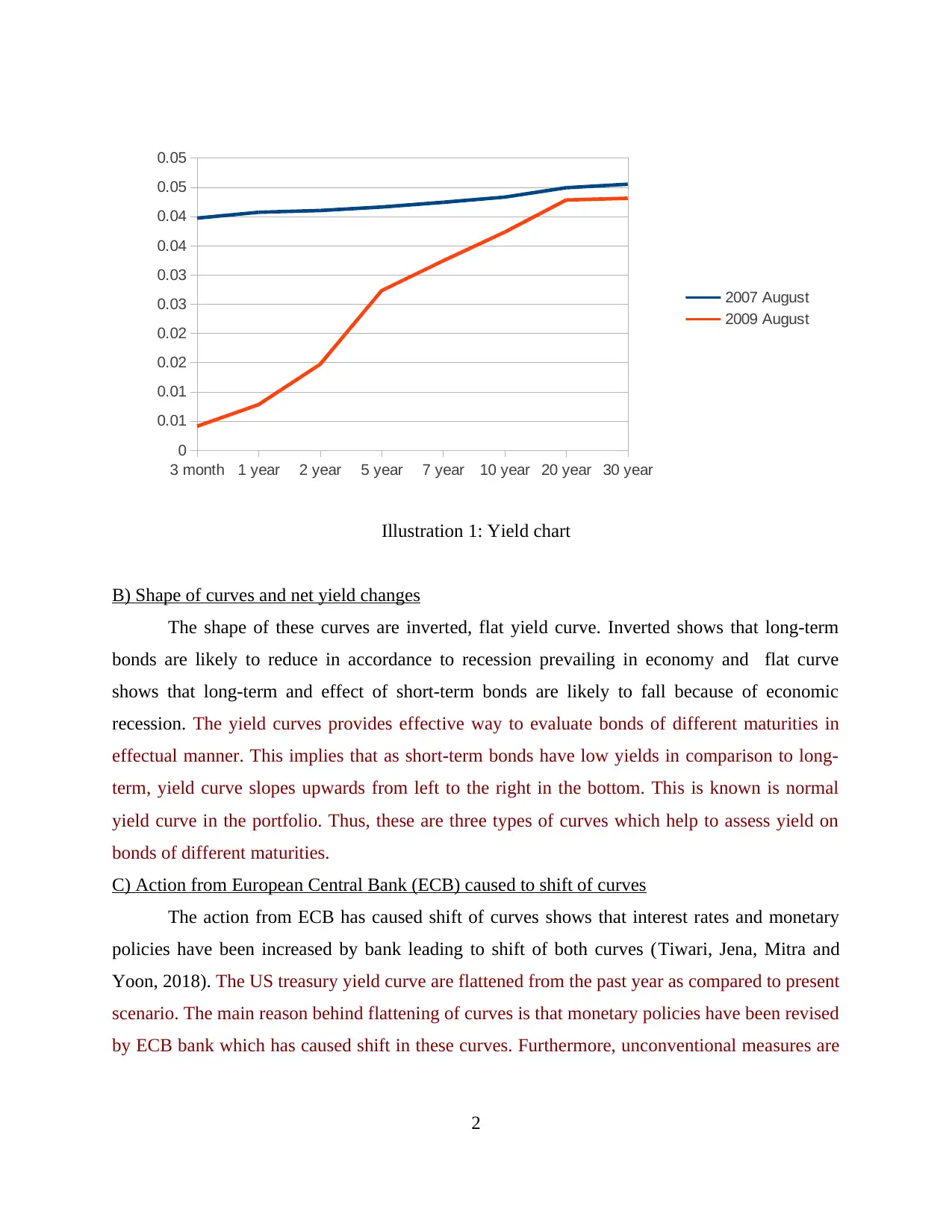
B) Shape of curves and net yield changes
The shape of these curves are inverted, flat yield curve. Inverted shows that long-term
bonds are likely to reduce in accordance to recession prevailing in economy and flat curve
shows that long-term and effect of short-term bonds are likely to fall because of economic
recession. The yield curves provides effective way to evaluate bonds of different maturities in
effectual manner. This implies that as short-term bonds have low yields in comparison to long-
term, yield curve slopes upwards from left to the right in the bottom. This is known is normal
yield curve in the portfolio. Thus, these are three types of curves which help to assess yield on
bonds of different maturities.
C) Action from European Central Bank (ECB) caused to shift of curves
The action from ECB has caused shift of curves shows that interest rates and monetary
policies have been increased by bank leading to shift of both curves (Tiwari, Jena, Mitra and
Yoon, 2018). The US treasury yield curve are flattened from the past year as compared to present
scenario. The main reason behind flattening of curves is that monetary policies have been revised
by ECB bank which has caused shift in these curves. Furthermore, unconventional measures are
2
3 month 1 year 2 year 5 year 7 year 10 year 20 year 30 year
0
0.01
0.01
0.02
0.02
0.03
0.03
0.04
0.04
0.05
0.05
2007 August
2009 August
Illustration 1: Yield chart
The shape of these curves are inverted, flat yield curve. Inverted shows that long-term
bonds are likely to reduce in accordance to recession prevailing in economy and flat curve
shows that long-term and effect of short-term bonds are likely to fall because of economic
recession. The yield curves provides effective way to evaluate bonds of different maturities in
effectual manner. This implies that as short-term bonds have low yields in comparison to long-
term, yield curve slopes upwards from left to the right in the bottom. This is known is normal
yield curve in the portfolio. Thus, these are three types of curves which help to assess yield on
bonds of different maturities.
C) Action from European Central Bank (ECB) caused to shift of curves
The action from ECB has caused shift of curves shows that interest rates and monetary
policies have been increased by bank leading to shift of both curves (Tiwari, Jena, Mitra and
Yoon, 2018). The US treasury yield curve are flattened from the past year as compared to present
scenario. The main reason behind flattening of curves is that monetary policies have been revised
by ECB bank which has caused shift in these curves. Furthermore, unconventional measures are
2
3 month 1 year 2 year 5 year 7 year 10 year 20 year 30 year
0
0.01
0.01
0.02
0.02
0.03
0.03
0.04
0.04
0.05
0.05
2007 August
2009 August
Illustration 1: Yield chart
Paraphrase This Document
Need a fresh take? Get an instant paraphrase of this document with our AI Paraphraser

taken such as negative rates and buying of assets and as such, this has caused flattening of curves
in the country. Moreover, interest rates are also being updated by the bank.
D) Concentrate on holdings for better performance
The concentrate on holdings from the period is 30 year as in August 4.55 % bond yield
prevailed. This is evident from the curves that such time period is quite good as more return
would be generated which will help investor in attaining higher returns with much ease. Thus,
concentrate on holdings for 30 year, better performance may be achieved (Kaiser, Arbi and
Ahlemann, 2015).
E) Evaluating various strategies having different returns
Bullish flattening trades
This means that yield curve become flat because long-term interest rates falls quicker
than short-term ones. This happens when safe trade is made or another reason may be inflation
expectations are reduced. It is known as bullish flattening trade as it causes changes in curve and
the same comes prior to fed that lowers down interest rates of short-term basis and is called as
bullish for share and economy market.
Bearish flattening trades
This implies short-term interest rate rise quicker than long-term ones. The curve causes
shift as change in it often come prior to fed that raises up interest rates of short-term. Thus, it is
bearish for both the above discussed markets.
Bullish steepening trades
This trade shows that short-term interest rate falls quicker than long-term rates. The main
cause of bullish steepening trade is that expectation related to fed is lower interest rates which is
bullish for the markets.
Bearish steepening trades
This is a situation when long-term rate rise more than short-term. It causes bearish
steepening trade as expectation of inflation raises and as such, market estimate fed maximise to
effectively fight with inflation. Thus, this is known as bearish for stock and economy markets
(Klingebiel and Rammer, 2014).
3
in the country. Moreover, interest rates are also being updated by the bank.
D) Concentrate on holdings for better performance
The concentrate on holdings from the period is 30 year as in August 4.55 % bond yield
prevailed. This is evident from the curves that such time period is quite good as more return
would be generated which will help investor in attaining higher returns with much ease. Thus,
concentrate on holdings for 30 year, better performance may be achieved (Kaiser, Arbi and
Ahlemann, 2015).
E) Evaluating various strategies having different returns
Bullish flattening trades
This means that yield curve become flat because long-term interest rates falls quicker
than short-term ones. This happens when safe trade is made or another reason may be inflation
expectations are reduced. It is known as bullish flattening trade as it causes changes in curve and
the same comes prior to fed that lowers down interest rates of short-term basis and is called as
bullish for share and economy market.
Bearish flattening trades
This implies short-term interest rate rise quicker than long-term ones. The curve causes
shift as change in it often come prior to fed that raises up interest rates of short-term. Thus, it is
bearish for both the above discussed markets.
Bullish steepening trades
This trade shows that short-term interest rate falls quicker than long-term rates. The main
cause of bullish steepening trade is that expectation related to fed is lower interest rates which is
bullish for the markets.
Bearish steepening trades
This is a situation when long-term rate rise more than short-term. It causes bearish
steepening trade as expectation of inflation raises and as such, market estimate fed maximise to
effectively fight with inflation. Thus, this is known as bearish for stock and economy markets
(Klingebiel and Rammer, 2014).
3
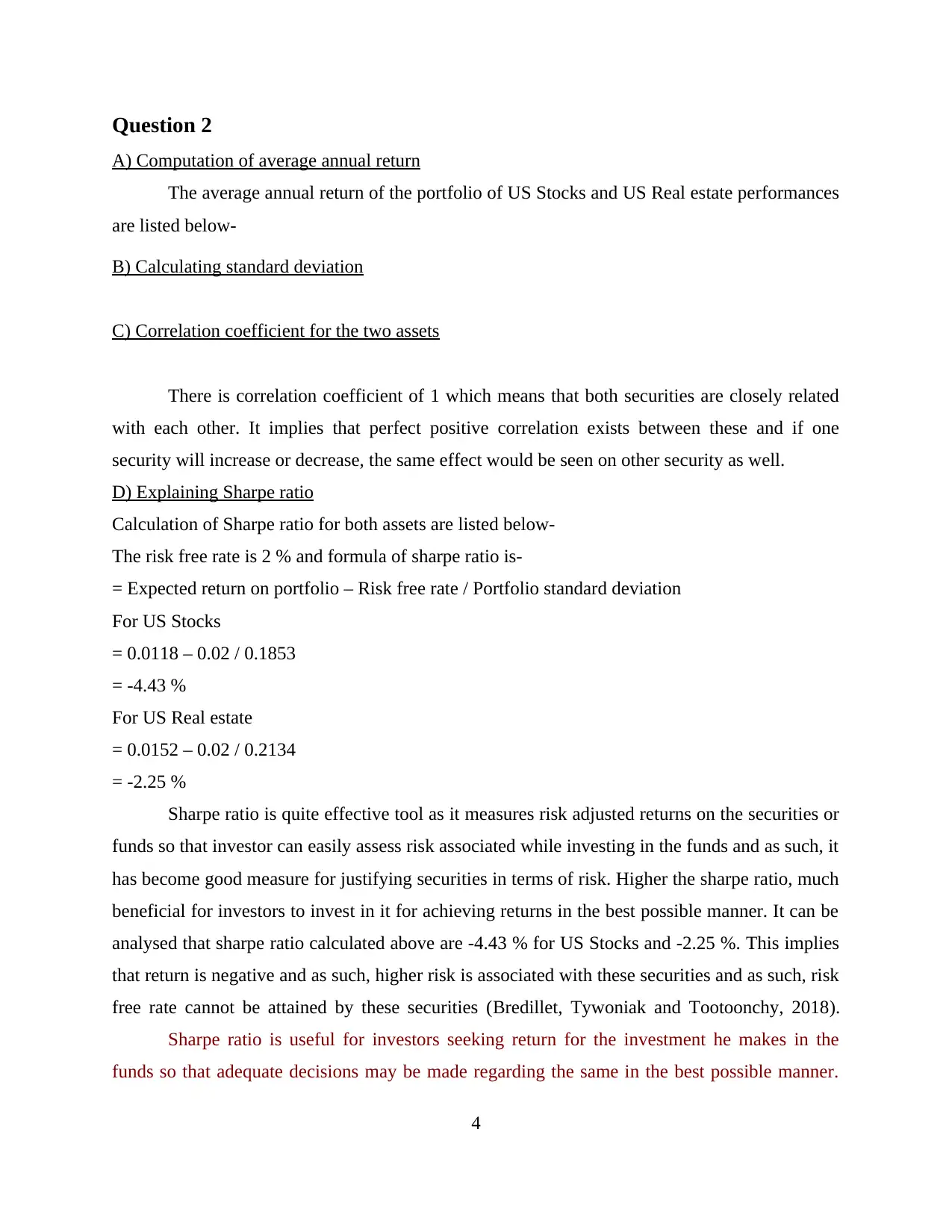
Question 2
A) Computation of average annual return
The average annual return of the portfolio of US Stocks and US Real estate performances
are listed below-
B) Calculating standard deviation
C) Correlation coefficient for the two assets
There is correlation coefficient of 1 which means that both securities are closely related
with each other. It implies that perfect positive correlation exists between these and if one
security will increase or decrease, the same effect would be seen on other security as well.
D) Explaining Sharpe ratio
Calculation of Sharpe ratio for both assets are listed below-
The risk free rate is 2 % and formula of sharpe ratio is-
= Expected return on portfolio – Risk free rate / Portfolio standard deviation
For US Stocks
= 0.0118 – 0.02 / 0.1853
= -4.43 %
For US Real estate
= 0.0152 – 0.02 / 0.2134
= -2.25 %
Sharpe ratio is quite effective tool as it measures risk adjusted returns on the securities or
funds so that investor can easily assess risk associated while investing in the funds and as such, it
has become good measure for justifying securities in terms of risk. Higher the sharpe ratio, much
beneficial for investors to invest in it for achieving returns in the best possible manner. It can be
analysed that sharpe ratio calculated above are -4.43 % for US Stocks and -2.25 %. This implies
that return is negative and as such, higher risk is associated with these securities and as such, risk
free rate cannot be attained by these securities (Bredillet, Tywoniak and Tootoonchy, 2018).
Sharpe ratio is useful for investors seeking return for the investment he makes in the
funds so that adequate decisions may be made regarding the same in the best possible manner.
4
A) Computation of average annual return
The average annual return of the portfolio of US Stocks and US Real estate performances
are listed below-
B) Calculating standard deviation
C) Correlation coefficient for the two assets
There is correlation coefficient of 1 which means that both securities are closely related
with each other. It implies that perfect positive correlation exists between these and if one
security will increase or decrease, the same effect would be seen on other security as well.
D) Explaining Sharpe ratio
Calculation of Sharpe ratio for both assets are listed below-
The risk free rate is 2 % and formula of sharpe ratio is-
= Expected return on portfolio – Risk free rate / Portfolio standard deviation
For US Stocks
= 0.0118 – 0.02 / 0.1853
= -4.43 %
For US Real estate
= 0.0152 – 0.02 / 0.2134
= -2.25 %
Sharpe ratio is quite effective tool as it measures risk adjusted returns on the securities or
funds so that investor can easily assess risk associated while investing in the funds and as such, it
has become good measure for justifying securities in terms of risk. Higher the sharpe ratio, much
beneficial for investors to invest in it for achieving returns in the best possible manner. It can be
analysed that sharpe ratio calculated above are -4.43 % for US Stocks and -2.25 %. This implies
that return is negative and as such, higher risk is associated with these securities and as such, risk
free rate cannot be attained by these securities (Bredillet, Tywoniak and Tootoonchy, 2018).
Sharpe ratio is useful for investors seeking return for the investment he makes in the
funds so that adequate decisions may be made regarding the same in the best possible manner.
4
⊘ This is a preview!⊘
Do you want full access?
Subscribe today to unlock all pages.

Trusted by 1+ million students worldwide
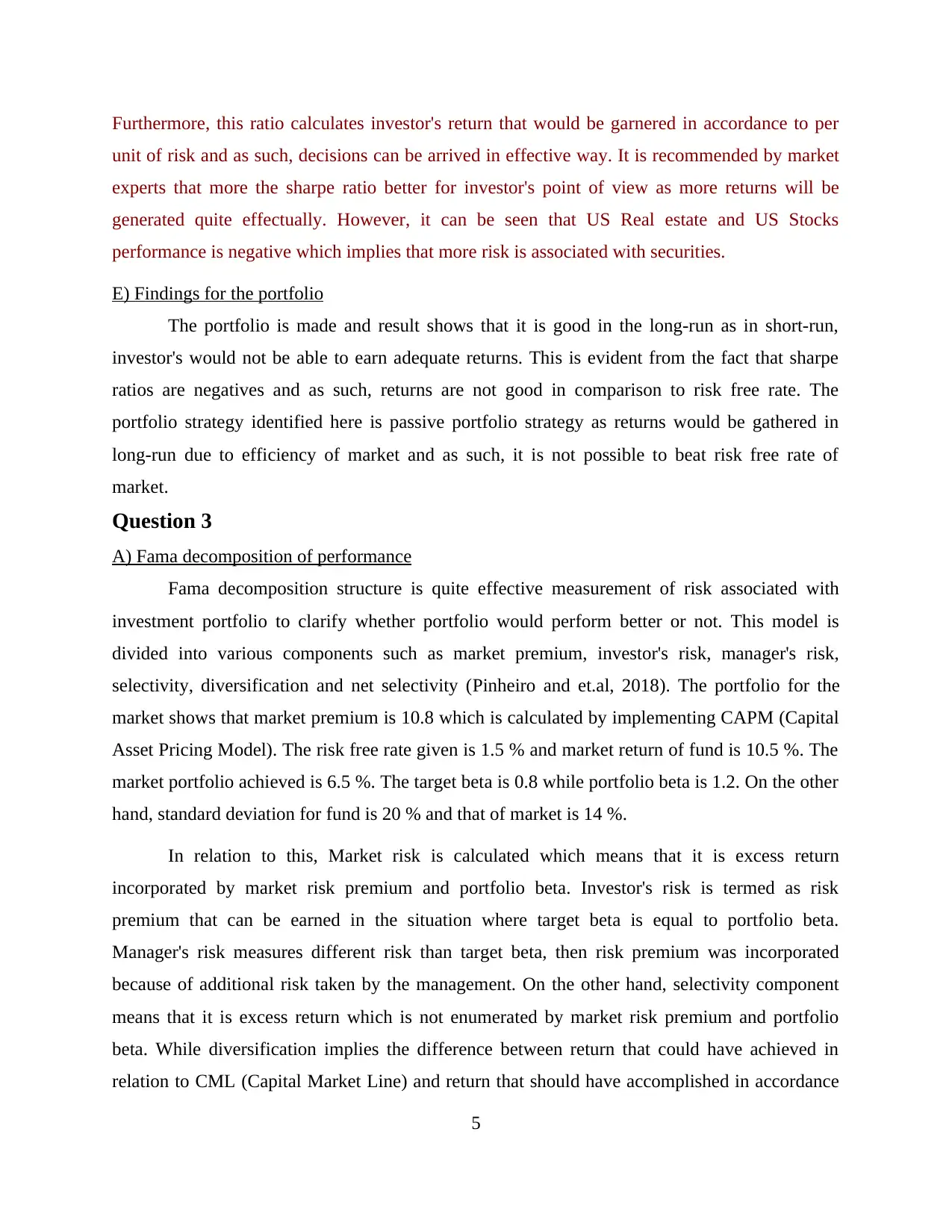
Furthermore, this ratio calculates investor's return that would be garnered in accordance to per
unit of risk and as such, decisions can be arrived in effective way. It is recommended by market
experts that more the sharpe ratio better for investor's point of view as more returns will be
generated quite effectually. However, it can be seen that US Real estate and US Stocks
performance is negative which implies that more risk is associated with securities.
E) Findings for the portfolio
The portfolio is made and result shows that it is good in the long-run as in short-run,
investor's would not be able to earn adequate returns. This is evident from the fact that sharpe
ratios are negatives and as such, returns are not good in comparison to risk free rate. The
portfolio strategy identified here is passive portfolio strategy as returns would be gathered in
long-run due to efficiency of market and as such, it is not possible to beat risk free rate of
market.
Question 3
A) Fama decomposition of performance
Fama decomposition structure is quite effective measurement of risk associated with
investment portfolio to clarify whether portfolio would perform better or not. This model is
divided into various components such as market premium, investor's risk, manager's risk,
selectivity, diversification and net selectivity (Pinheiro and et.al, 2018). The portfolio for the
market shows that market premium is 10.8 which is calculated by implementing CAPM (Capital
Asset Pricing Model). The risk free rate given is 1.5 % and market return of fund is 10.5 %. The
market portfolio achieved is 6.5 %. The target beta is 0.8 while portfolio beta is 1.2. On the other
hand, standard deviation for fund is 20 % and that of market is 14 %.
In relation to this, Market risk is calculated which means that it is excess return
incorporated by market risk premium and portfolio beta. Investor's risk is termed as risk
premium that can be earned in the situation where target beta is equal to portfolio beta.
Manager's risk measures different risk than target beta, then risk premium was incorporated
because of additional risk taken by the management. On the other hand, selectivity component
means that it is excess return which is not enumerated by market risk premium and portfolio
beta. While diversification implies the difference between return that could have achieved in
relation to CML (Capital Market Line) and return that should have accomplished in accordance
5
unit of risk and as such, decisions can be arrived in effective way. It is recommended by market
experts that more the sharpe ratio better for investor's point of view as more returns will be
generated quite effectually. However, it can be seen that US Real estate and US Stocks
performance is negative which implies that more risk is associated with securities.
E) Findings for the portfolio
The portfolio is made and result shows that it is good in the long-run as in short-run,
investor's would not be able to earn adequate returns. This is evident from the fact that sharpe
ratios are negatives and as such, returns are not good in comparison to risk free rate. The
portfolio strategy identified here is passive portfolio strategy as returns would be gathered in
long-run due to efficiency of market and as such, it is not possible to beat risk free rate of
market.
Question 3
A) Fama decomposition of performance
Fama decomposition structure is quite effective measurement of risk associated with
investment portfolio to clarify whether portfolio would perform better or not. This model is
divided into various components such as market premium, investor's risk, manager's risk,
selectivity, diversification and net selectivity (Pinheiro and et.al, 2018). The portfolio for the
market shows that market premium is 10.8 which is calculated by implementing CAPM (Capital
Asset Pricing Model). The risk free rate given is 1.5 % and market return of fund is 10.5 %. The
market portfolio achieved is 6.5 %. The target beta is 0.8 while portfolio beta is 1.2. On the other
hand, standard deviation for fund is 20 % and that of market is 14 %.
In relation to this, Market risk is calculated which means that it is excess return
incorporated by market risk premium and portfolio beta. Investor's risk is termed as risk
premium that can be earned in the situation where target beta is equal to portfolio beta.
Manager's risk measures different risk than target beta, then risk premium was incorporated
because of additional risk taken by the management. On the other hand, selectivity component
means that it is excess return which is not enumerated by market risk premium and portfolio
beta. While diversification implies the difference between return that could have achieved in
relation to CML (Capital Market Line) and return that should have accomplished in accordance
5
Paraphrase This Document
Need a fresh take? Get an instant paraphrase of this document with our AI Paraphraser
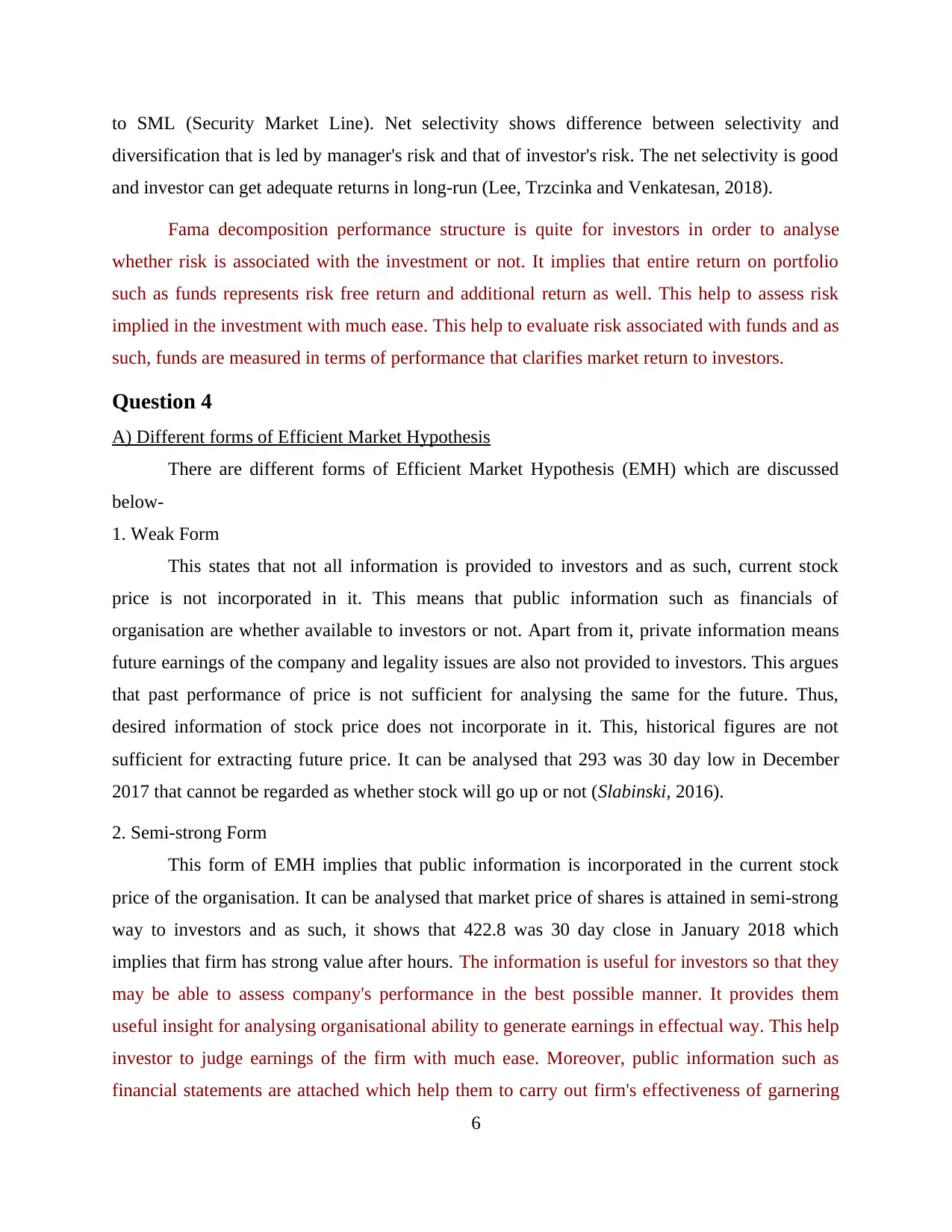
to SML (Security Market Line). Net selectivity shows difference between selectivity and
diversification that is led by manager's risk and that of investor's risk. The net selectivity is good
and investor can get adequate returns in long-run (Lee, Trzcinka and Venkatesan, 2018).
Fama decomposition performance structure is quite for investors in order to analyse
whether risk is associated with the investment or not. It implies that entire return on portfolio
such as funds represents risk free return and additional return as well. This help to assess risk
implied in the investment with much ease. This help to evaluate risk associated with funds and as
such, funds are measured in terms of performance that clarifies market return to investors.
Question 4
A) Different forms of Efficient Market Hypothesis
There are different forms of Efficient Market Hypothesis (EMH) which are discussed
below-
1. Weak Form
This states that not all information is provided to investors and as such, current stock
price is not incorporated in it. This means that public information such as financials of
organisation are whether available to investors or not. Apart from it, private information means
future earnings of the company and legality issues are also not provided to investors. This argues
that past performance of price is not sufficient for analysing the same for the future. Thus,
desired information of stock price does not incorporate in it. This, historical figures are not
sufficient for extracting future price. It can be analysed that 293 was 30 day low in December
2017 that cannot be regarded as whether stock will go up or not (Slabinski, 2016).
2. Semi-strong Form
This form of EMH implies that public information is incorporated in the current stock
price of the organisation. It can be analysed that market price of shares is attained in semi-strong
way to investors and as such, it shows that 422.8 was 30 day close in January 2018 which
implies that firm has strong value after hours. The information is useful for investors so that they
may be able to assess company's performance in the best possible manner. It provides them
useful insight for analysing organisational ability to generate earnings in effectual way. This help
investor to judge earnings of the firm with much ease. Moreover, public information such as
financial statements are attached which help them to carry out firm's effectiveness of garnering
6
diversification that is led by manager's risk and that of investor's risk. The net selectivity is good
and investor can get adequate returns in long-run (Lee, Trzcinka and Venkatesan, 2018).
Fama decomposition performance structure is quite for investors in order to analyse
whether risk is associated with the investment or not. It implies that entire return on portfolio
such as funds represents risk free return and additional return as well. This help to assess risk
implied in the investment with much ease. This help to evaluate risk associated with funds and as
such, funds are measured in terms of performance that clarifies market return to investors.
Question 4
A) Different forms of Efficient Market Hypothesis
There are different forms of Efficient Market Hypothesis (EMH) which are discussed
below-
1. Weak Form
This states that not all information is provided to investors and as such, current stock
price is not incorporated in it. This means that public information such as financials of
organisation are whether available to investors or not. Apart from it, private information means
future earnings of the company and legality issues are also not provided to investors. This argues
that past performance of price is not sufficient for analysing the same for the future. Thus,
desired information of stock price does not incorporate in it. This, historical figures are not
sufficient for extracting future price. It can be analysed that 293 was 30 day low in December
2017 that cannot be regarded as whether stock will go up or not (Slabinski, 2016).
2. Semi-strong Form
This form of EMH implies that public information is incorporated in the current stock
price of the organisation. It can be analysed that market price of shares is attained in semi-strong
way to investors and as such, it shows that 422.8 was 30 day close in January 2018 which
implies that firm has strong value after hours. The information is useful for investors so that they
may be able to assess company's performance in the best possible manner. It provides them
useful insight for analysing organisational ability to generate earnings in effectual way. This help
investor to judge earnings of the firm with much ease. Moreover, public information such as
financial statements are attached which help them to carry out firm's effectiveness of garnering
6
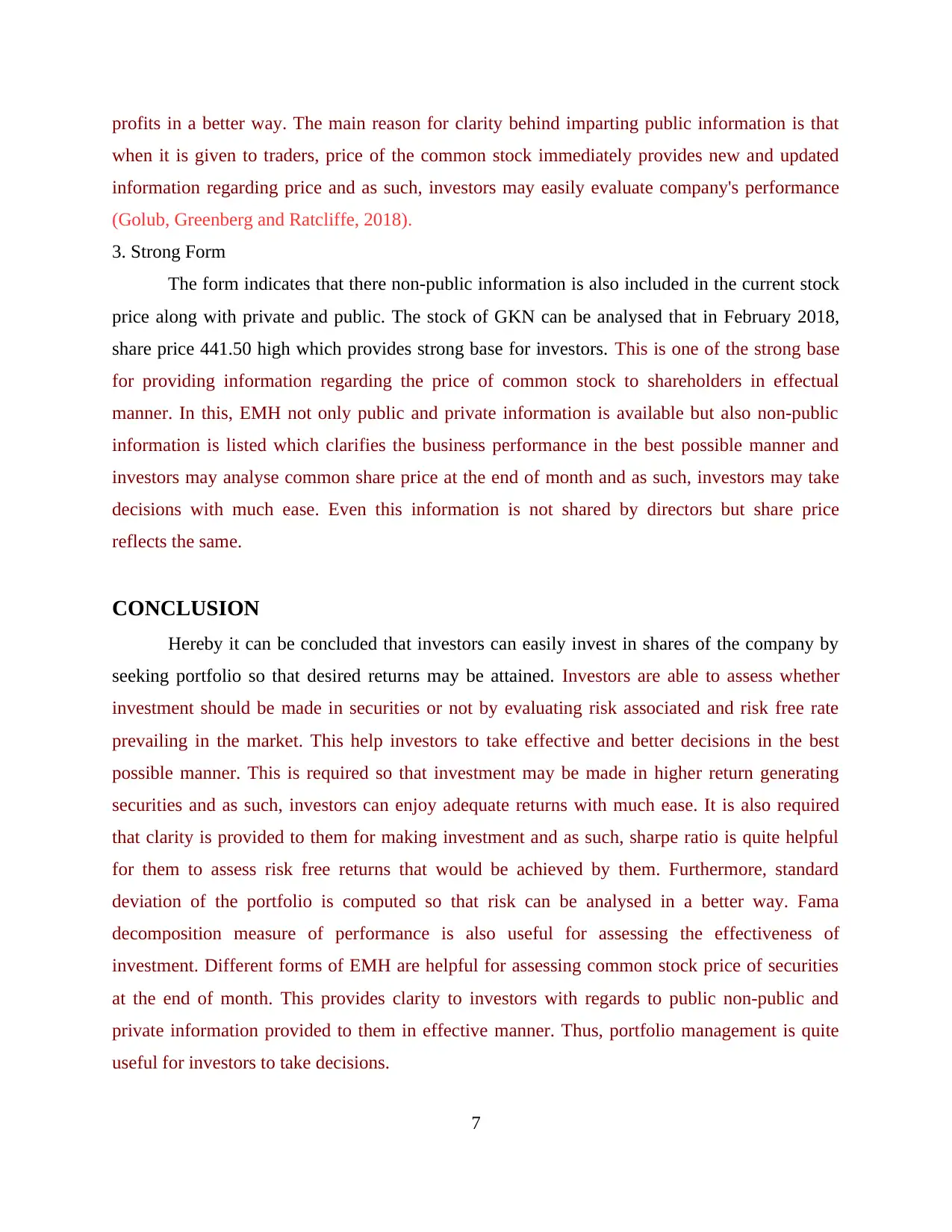
profits in a better way. The main reason for clarity behind imparting public information is that
when it is given to traders, price of the common stock immediately provides new and updated
information regarding price and as such, investors may easily evaluate company's performance
(Golub, Greenberg and Ratcliffe, 2018).
3. Strong Form
The form indicates that there non-public information is also included in the current stock
price along with private and public. The stock of GKN can be analysed that in February 2018,
share price 441.50 high which provides strong base for investors. This is one of the strong base
for providing information regarding the price of common stock to shareholders in effectual
manner. In this, EMH not only public and private information is available but also non-public
information is listed which clarifies the business performance in the best possible manner and
investors may analyse common share price at the end of month and as such, investors may take
decisions with much ease. Even this information is not shared by directors but share price
reflects the same.
CONCLUSION
Hereby it can be concluded that investors can easily invest in shares of the company by
seeking portfolio so that desired returns may be attained. Investors are able to assess whether
investment should be made in securities or not by evaluating risk associated and risk free rate
prevailing in the market. This help investors to take effective and better decisions in the best
possible manner. This is required so that investment may be made in higher return generating
securities and as such, investors can enjoy adequate returns with much ease. It is also required
that clarity is provided to them for making investment and as such, sharpe ratio is quite helpful
for them to assess risk free returns that would be achieved by them. Furthermore, standard
deviation of the portfolio is computed so that risk can be analysed in a better way. Fama
decomposition measure of performance is also useful for assessing the effectiveness of
investment. Different forms of EMH are helpful for assessing common stock price of securities
at the end of month. This provides clarity to investors with regards to public non-public and
private information provided to them in effective manner. Thus, portfolio management is quite
useful for investors to take decisions.
7
when it is given to traders, price of the common stock immediately provides new and updated
information regarding price and as such, investors may easily evaluate company's performance
(Golub, Greenberg and Ratcliffe, 2018).
3. Strong Form
The form indicates that there non-public information is also included in the current stock
price along with private and public. The stock of GKN can be analysed that in February 2018,
share price 441.50 high which provides strong base for investors. This is one of the strong base
for providing information regarding the price of common stock to shareholders in effectual
manner. In this, EMH not only public and private information is available but also non-public
information is listed which clarifies the business performance in the best possible manner and
investors may analyse common share price at the end of month and as such, investors may take
decisions with much ease. Even this information is not shared by directors but share price
reflects the same.
CONCLUSION
Hereby it can be concluded that investors can easily invest in shares of the company by
seeking portfolio so that desired returns may be attained. Investors are able to assess whether
investment should be made in securities or not by evaluating risk associated and risk free rate
prevailing in the market. This help investors to take effective and better decisions in the best
possible manner. This is required so that investment may be made in higher return generating
securities and as such, investors can enjoy adequate returns with much ease. It is also required
that clarity is provided to them for making investment and as such, sharpe ratio is quite helpful
for them to assess risk free returns that would be achieved by them. Furthermore, standard
deviation of the portfolio is computed so that risk can be analysed in a better way. Fama
decomposition measure of performance is also useful for assessing the effectiveness of
investment. Different forms of EMH are helpful for assessing common stock price of securities
at the end of month. This provides clarity to investors with regards to public non-public and
private information provided to them in effective manner. Thus, portfolio management is quite
useful for investors to take decisions.
7
⊘ This is a preview!⊘
Do you want full access?
Subscribe today to unlock all pages.

Trusted by 1+ million students worldwide
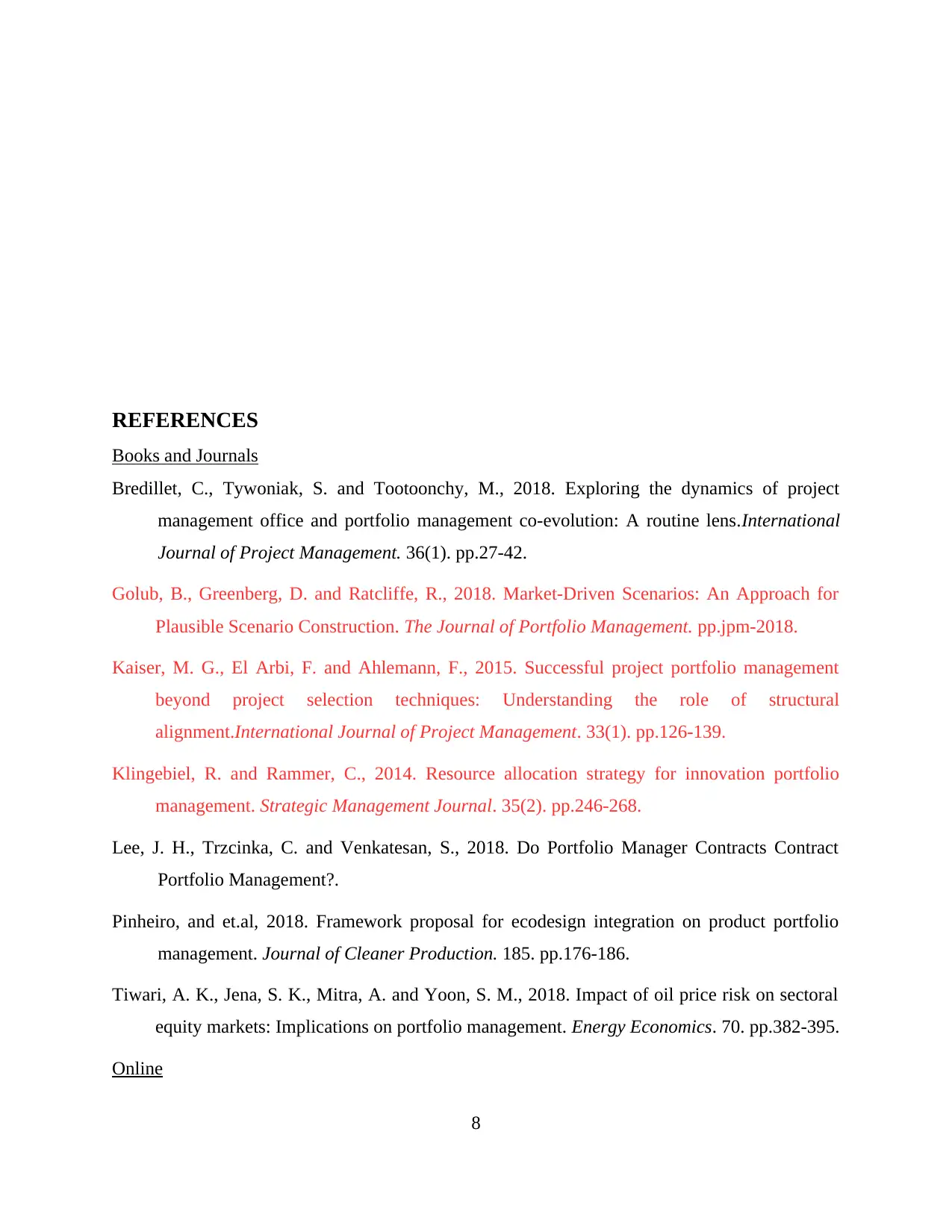
REFERENCES
Books and Journals
Bredillet, C., Tywoniak, S. and Tootoonchy, M., 2018. Exploring the dynamics of project
management office and portfolio management co-evolution: A routine lens.International
Journal of Project Management. 36(1). pp.27-42.
Golub, B., Greenberg, D. and Ratcliffe, R., 2018. Market-Driven Scenarios: An Approach for
Plausible Scenario Construction. The Journal of Portfolio Management. pp.jpm-2018.
Kaiser, M. G., El Arbi, F. and Ahlemann, F., 2015. Successful project portfolio management
beyond project selection techniques: Understanding the role of structural
alignment.International Journal of Project Management. 33(1). pp.126-139.
Klingebiel, R. and Rammer, C., 2014. Resource allocation strategy for innovation portfolio
management. Strategic Management Journal. 35(2). pp.246-268.
Lee, J. H., Trzcinka, C. and Venkatesan, S., 2018. Do Portfolio Manager Contracts Contract
Portfolio Management?.
Pinheiro, and et.al, 2018. Framework proposal for ecodesign integration on product portfolio
management. Journal of Cleaner Production. 185. pp.176-186.
Tiwari, A. K., Jena, S. K., Mitra, A. and Yoon, S. M., 2018. Impact of oil price risk on sectoral
equity markets: Implications on portfolio management. Energy Economics. 70. pp.382-395.
Online
8
Books and Journals
Bredillet, C., Tywoniak, S. and Tootoonchy, M., 2018. Exploring the dynamics of project
management office and portfolio management co-evolution: A routine lens.International
Journal of Project Management. 36(1). pp.27-42.
Golub, B., Greenberg, D. and Ratcliffe, R., 2018. Market-Driven Scenarios: An Approach for
Plausible Scenario Construction. The Journal of Portfolio Management. pp.jpm-2018.
Kaiser, M. G., El Arbi, F. and Ahlemann, F., 2015. Successful project portfolio management
beyond project selection techniques: Understanding the role of structural
alignment.International Journal of Project Management. 33(1). pp.126-139.
Klingebiel, R. and Rammer, C., 2014. Resource allocation strategy for innovation portfolio
management. Strategic Management Journal. 35(2). pp.246-268.
Lee, J. H., Trzcinka, C. and Venkatesan, S., 2018. Do Portfolio Manager Contracts Contract
Portfolio Management?.
Pinheiro, and et.al, 2018. Framework proposal for ecodesign integration on product portfolio
management. Journal of Cleaner Production. 185. pp.176-186.
Tiwari, A. K., Jena, S. K., Mitra, A. and Yoon, S. M., 2018. Impact of oil price risk on sectoral
equity markets: Implications on portfolio management. Energy Economics. 70. pp.382-395.
Online
8
Paraphrase This Document
Need a fresh take? Get an instant paraphrase of this document with our AI Paraphraser
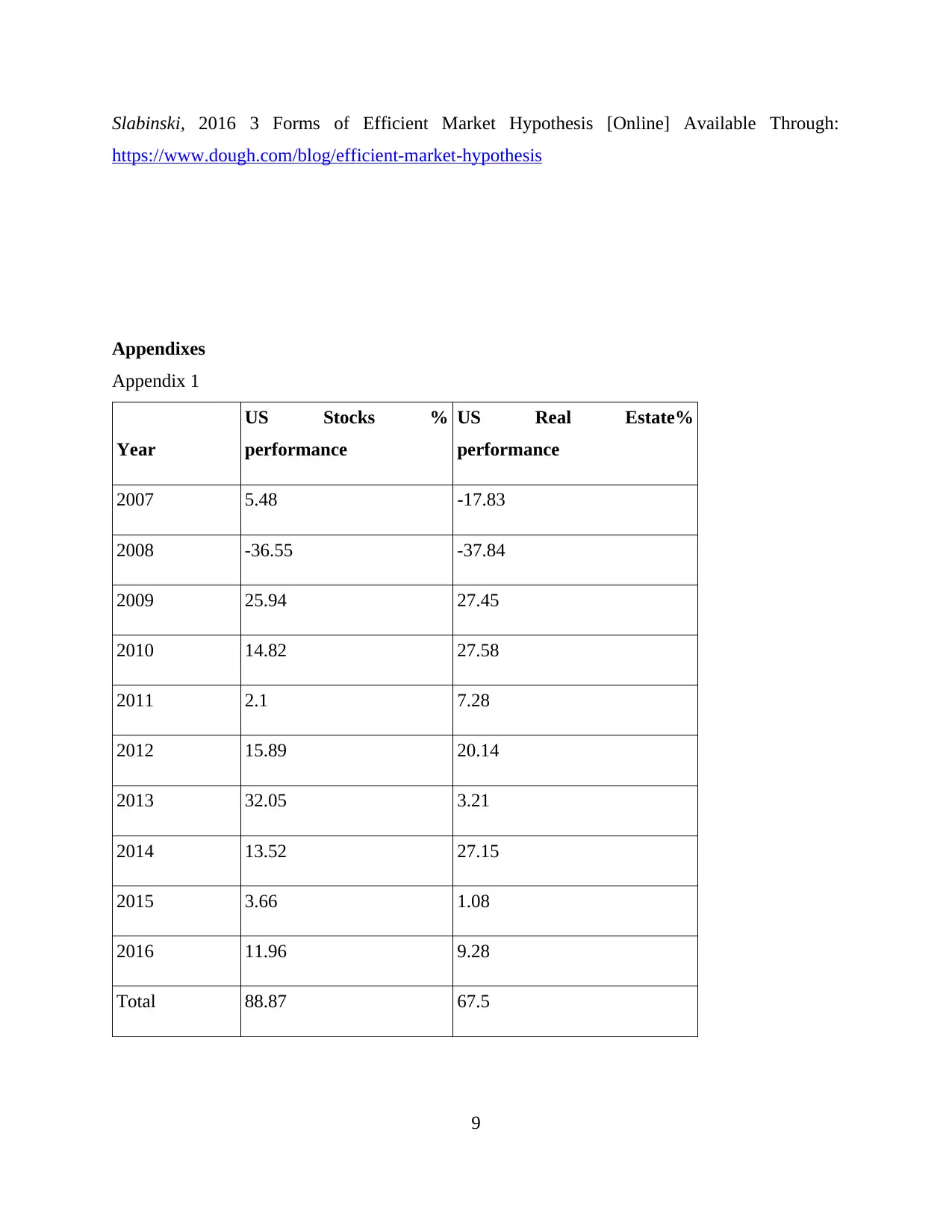
Slabinski, 2016 3 Forms of Efficient Market Hypothesis [Online] Available Through:
https://www.dough.com/blog/efficient-market-hypothesis
Appendixes
Appendix 1
Year
US Stocks %
performance
US Real Estate%
performance
2007 5.48 -17.83
2008 -36.55 -37.84
2009 25.94 27.45
2010 14.82 27.58
2011 2.1 7.28
2012 15.89 20.14
2013 32.05 3.21
2014 13.52 27.15
2015 3.66 1.08
2016 11.96 9.28
Total 88.87 67.5
9
https://www.dough.com/blog/efficient-market-hypothesis
Appendixes
Appendix 1
Year
US Stocks %
performance
US Real Estate%
performance
2007 5.48 -17.83
2008 -36.55 -37.84
2009 25.94 27.45
2010 14.82 27.58
2011 2.1 7.28
2012 15.89 20.14
2013 32.05 3.21
2014 13.52 27.15
2015 3.66 1.08
2016 11.96 9.28
Total 88.87 67.5
9
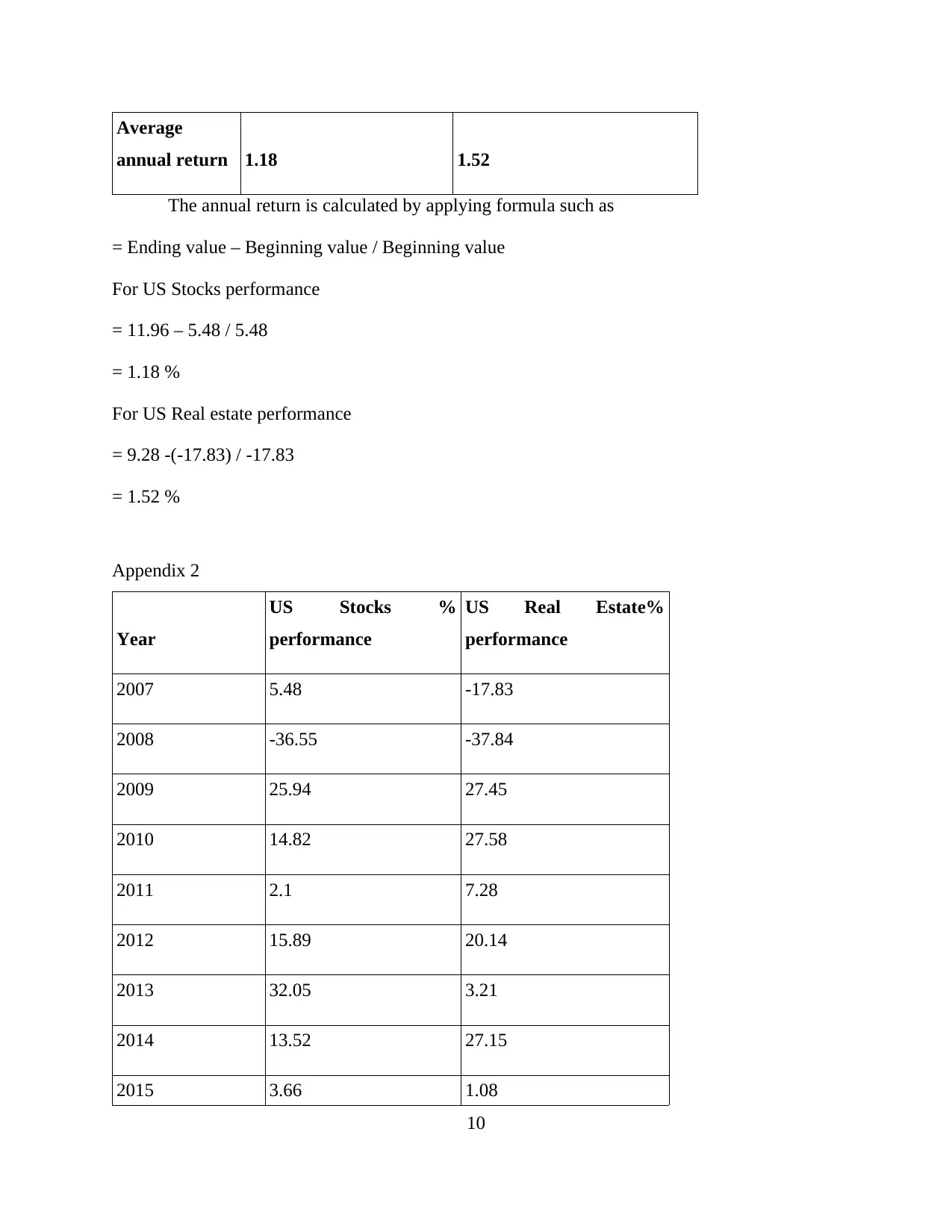
Average
annual return 1.18 1.52
The annual return is calculated by applying formula such as
= Ending value – Beginning value / Beginning value
For US Stocks performance
= 11.96 – 5.48 / 5.48
= 1.18 %
For US Real estate performance
= 9.28 -(-17.83) / -17.83
= 1.52 %
Appendix 2
Year
US Stocks %
performance
US Real Estate%
performance
2007 5.48 -17.83
2008 -36.55 -37.84
2009 25.94 27.45
2010 14.82 27.58
2011 2.1 7.28
2012 15.89 20.14
2013 32.05 3.21
2014 13.52 27.15
2015 3.66 1.08
10
annual return 1.18 1.52
The annual return is calculated by applying formula such as
= Ending value – Beginning value / Beginning value
For US Stocks performance
= 11.96 – 5.48 / 5.48
= 1.18 %
For US Real estate performance
= 9.28 -(-17.83) / -17.83
= 1.52 %
Appendix 2
Year
US Stocks %
performance
US Real Estate%
performance
2007 5.48 -17.83
2008 -36.55 -37.84
2009 25.94 27.45
2010 14.82 27.58
2011 2.1 7.28
2012 15.89 20.14
2013 32.05 3.21
2014 13.52 27.15
2015 3.66 1.08
10
⊘ This is a preview!⊘
Do you want full access?
Subscribe today to unlock all pages.

Trusted by 1+ million students worldwide
1 out of 13
Your All-in-One AI-Powered Toolkit for Academic Success.
+13062052269
info@desklib.com
Available 24*7 on WhatsApp / Email
![[object Object]](/_next/static/media/star-bottom.7253800d.svg)
Unlock your academic potential
Copyright © 2020–2025 A2Z Services. All Rights Reserved. Developed and managed by ZUCOL.
